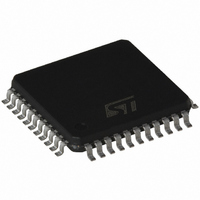TDA7405 STMicroelectronics, TDA7405 Datasheet - Page 35

TDA7405
Manufacturer Part Number
TDA7405
Description
IC PROCESSOR EQUALIZER 44-TQFP
Manufacturer
STMicroelectronics
Type
Car Signal Processorr
Datasheet
1.STN1NF10.pdf
(57 pages)
Specifications of TDA7405
Mounting Type
Surface Mount
Package / Case
44-TQFP, 44-VQFP
Lead Free Status / RoHS Status
Lead free / RoHS Compliant
Applications
-
Available stocks
Company
Part Number
Manufacturer
Quantity
Price
Company:
Part Number:
TDA7405TR
Manufacturer:
STMicroelectronics
Quantity:
10 000
TDA7405
The low threshold is active in combination with a good MPX signal without noise; the PEAK voltage is less than
1V. The sensitivity in this operation is high. If the MPX signal is noisy (low fieldstrength) the PEAK voltage in-
creases due to the higher noise, which is also rectified. With increasing of the PEAK voltage the trigger threshold
increases, too. This gain is programmable in 4 steps (see Figure 25).
11.3 Additional Threshold Control Mechanism
11.3.1Automatic Threshold Control by the Stereoblend voltage
Besides the noise controlled threshold adjustment there is an additional possibility for influencing the trigger
threshold which depends on the stereoblend control.
The point where the MPX signal starts to become noisy is fixed by the RF part. Therefore also the starting point
of the normal noise-controlled trigger adjustment is fixed (Figure 27). In some cases the behavior of the noise-
blanker can be improved by increasing the threshold even in a region of higher fieldstrength. Sometimes a
wrong triggering occurs for the MPX signal often shows distortion in this range which can be avoided even if
using a low threshold. Because of the overlap of this range and the range of the stereo/mono transition it can
be controlled by stereoblend. This increase of the threshold is programmable in 3 steps or switched off.
11.3.2Over Deviation Detector
If the system is tuned to stations with a high deviation the noiseblanker can trigger on the higher frequencies
of the modulation or distortion. To avoid this behavior, which causes audible noise in the output signal, the
noiseblanker offers a deviation-dependent threshold adjustment. By rectifying the MPX signal a further signal
representing the actual deviation is obtained. It is used to increase the PEAK voltage. Offset and gain of this
circuit are programmable in 3 steps with the bits D
and D
of the noiseblanker-byte I (bit combination '00' turns
6
7
off the detector, see Figure 26).
11.3.3Multipath-Level
To react on high repetitive spikes caused by a Multipath-situation, the discharge-time of the PEAK voltage can
be decreased depending on the voltage-level at pin MPout. The A631 offers a linear as well as a threshold driv-
en control. The linear influence of the Multipath-Level on the PEAK-signal (D
of Multipath-Control-Byte) gives
7
1
a discharge slewrate of 1V/ms
. The second possibility is to activate the threshold driven discharge which
switches on the 18kOhm discharge if the Multipath-Level is below 2.5V (D
of noiseblanker-byte II-byte).
7
1
The slewrate is measured with R
= nfinite and V
= 2.5V
Discharge
MPout
11.3.4AM mode of the Noiseblanker
The A631 noiseblanker is also suitable for AM noise canceling. The detector uses in AM mode the 450kHz un-
filtered IF-output of the tuner for spike detection. A combination of programmable gain-stage and lowpass-filter
forms an envelope detector which drives the noiseblanker's input via a 120 kHz 1.st order highpass. In order to
blank the whole spike in AM mode the hold-times of the sample and hold circuit are much longer then in FM
(640µs to 1.2ms). All threshold controls can be used like in FM mode.
11.4 Functional Description of the Multipath-Detector
Using the Multipath-Detector the audible effects of a multipath condition can be minimized. A multipath-condi-
tion is detected by rectifying the spectrum around 19kHz in the fieldstrength signal. An external capacitor is used
to define the attack- and decay-times for the Stereoblend (see blockdiagram, Figure 35). Due to the very small
charge currents this capacitor should be a low leakage current type (e.g. ceramic). Using this configuration an
adaptation to the user's requirement is possible without effecting the "normal" fieldstrength input (LEVEL) for
the stereodecoder. This application is given in Figure 35. Another (internal) time constant is used to control the
Highcut through the multipath detector
Selecting the "internal influence" in the configuration byte the Stereo-Blend and/or the Highcut is automatically
invoked during a multipath condition according to the voltage appearing at the MP_OUT-pin.
35/57













